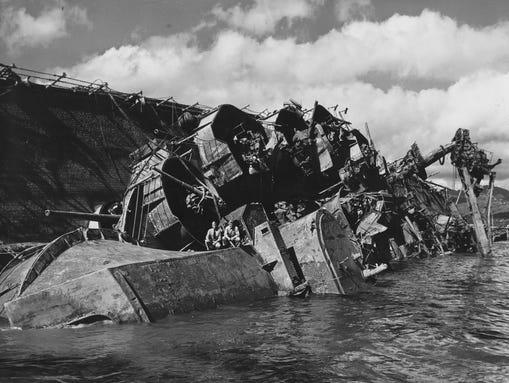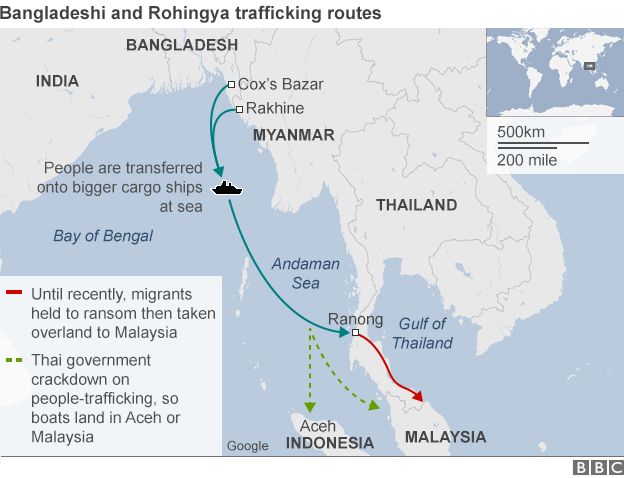
A gram of bone. If well-preserved and accompanied by the right genetic reference samples, it's enough to put a name and a face on an unknown soul thought lost to the ages.
In the coming months and years, experts in Dover and Hawaii will analyze nearly 400 such fragments, and the remains from which they're taken, as they launch a project with particular resonance this Memorial Day: identifying the sailors and Marines killed on Dec. 7, 1941, when Japanese attackers sank the USS Oklahoma. For the past 65 years, those remains have been buried as unknowns in graves at the National Memorial Cemetery of the Pacific in Honolulu.
The experts' work at two agencies with a long history of teaming up: the Armed Forces DNA Identification Laboratory at Dover Air Force Base and the newly reorganized Defense POW/MIA Accountability Agency in Hawaii.
Preservation was an unlikely byproduct of the two years the fallen sailors and Marines spent in their watery grave before the ship was righted during a massive salvage operation. No one knew it at the time, but the skeletonized bodies that were recovered were exposed to leaking fuel oil that would protect the bones from micro-organisms, preserving the DNA.
"That has actually inhibited bacterial growth in the remains," said Debra Prince Zinni, a forensic anthropologist with the Defense POW/MIA Accountability Agency, or DPAA. "And the success rate in getting the DNA from the remains is extremely high."
The exhumations will begin in June, according to Navy Capt. Edward Reedy, a forensic pathologist and as DPAA's medical examiner, the Defense Department's top identification official for past conflicts.
Initially, officials will try to match remains with dental records. Anthropological comparisons will follow. A DNA technician will cut the bone samples to be sent to Dover, where scientists and technicians working in sealed, sterile labs at the Armed Forces DNA lab will examine them.
The DNA results will be returned to Hawaii, where all the research will be combined to provide positive identifications, and subsequent release of remains to surviving family members.
"This is a project that I've been working on for many, many years now," said Zinni, who grew up in Wilmington and attended Ursuline Academy, where she was a standout athlete. "And to see that there's finally going to be some movement toward the identification is really remarkable. It's very rewarding work. But more than that, it's actually very humbling to be able to help these families get answers."
Many should. Between family reference DNA samples and dental records, officials have identifying information for about 88 percent of those unaccounted for, according to Tim McMahon, the Armed Forces DNA lab's deputy director for forensic services. Combined with advances in DNA science, he said they expect a high number of identifications.
"We expect that at least 80 percent ... will be individually identified," Zinni said.
In 2003, independent research convinced officials to unearth one casket of Oklahoma unknowns. Through the work of Zinni and others, five crewmen were identified, bringing the total recovered from the ship and unaccounted for to 388 (another Oklahoma sailor who'd been recovered from outside the ship and not buried with the ship's unidentified crewmen was identified in 2007).
Additional anthropological, dental and DNA analysis of the casket determined that it contained the sparse remains of more than 100 individuals. This prompted the Navy and Marine Corps to begin collecting reference samples from surviving family members.
In 2009, Congress, unhappy with the pace of positive identifications, mandated an increase to 200 missing service members annually by 2015. A year ago, then-Defense Secretary Chuck Hagel ordered an overhaul of the process, merging the two organizations responsible for finding missing personnel from past conflicts into the Defense POW/MIA Accounting Agency.
The Navy didn't want the Oklahoma exhumation to happen. In a May 2014 letter to family members of the Oklahoma crew, obtained and published by Stars and Stripes, a senior Navy official argued that "the sailors and Marines of USS Oklahoma would be outside the sanctity of the grave for a third time following their heroic sacrifice at Pearl Harbor." It would also be a drawn-out process, the official wrote, and "many" would likely remain unaccounted for.
Last month, the Pentagon overruled. Deputy Defense Secretary Robert Work, citing advances in forensic science and extensive family member participation in the collection of reference samples, ordered the project to begin and be completed within five years. He also ordered the disinterment of the remains of all unknowns in all permanent U.S. military cemeteries, given certain criteria.
The Japanese attack on Pearl Harbor 73 years ago was timed to catch the U.S. Navy on a sleepy Sunday morning. Shortly before 8 a.m., Japanese aircrews attacked, zeroing in on the eight battleships in port, seven of them parked in a row alongside Ford Island. Three air-launched torpedoes struck the Oklahoma, which was moored outboard of the USS Maryland. Multiple torpedo hits followed, ripping open Oklahoma's port side.
According to the Maryland's deck log, the 583-foot battleship began capsizing at 8:10 a.m. It was one of eight battleships – and 21 vessels, all told – sunk or badly damaged. Another 188 aircraft were destroyed and 2,403 Americans were killed.
Thirty-two crewmen were rescued from the overturned Oklahoma by civilian shipyard crews who struggled to cut through the bottom of the ship with pneumatic hammers and torches. A total of 429 crew members were killed – none from Delaware – and most were recovered from the ship during salvage operations, from July 1942 to May 1944.
Of those, 36 were positively identified and buried, leaving 393 buried in two Navy cemeteries until September 1947, when all were disinterred and moved to the Army's Central Identification Laboratory.
The bones had been "generally commingled." At the time, the only accepted way to identify skeletonized remains was through dental records, and 27 exhumed crewmen were identified in this way. Official arguments over whether or not to present a skull to a family without other associated remains, however, ended the effort. By 1950, all were buried in 61 caskets, interred in 45 locations, at the national cemetery in Honolulu, known as "The Punchbowl."
Beginning next month, the remains will again be exhumed. Four to six stainless steel caskets will arrive at the Defense POW/MIA Accounting Agency at any one time. Each will have a technician and scientist removing the remains, wrapped in green wool Army blankets, and cleaning them for examination.
Forensic dentists will examine the skulls and most likely make the first identifications, Zinni said. Positive matches to dental records will be considered as positive IDs, and families will be notified and given the choice to either accept the fragments or wait for further post-cranial identification that could associate other portions of the skeleton with that sailor or Marine.
Meanwhile, a DNA technician will cut the bone samples to be sent to Dover. The minimum required size is 0.8 grams, but Reedy said the agency usually sends about twice that amount. Ninety percent of a body's bones will yield testable amounts of DNA; the best samples are taken from the densest bones, such as femurs, according to Reedy.
Human cells with a nucleus contain two forms of DNA: nuclear and mitochondrial. Every nucleated cell has a single nucleus, and people get half of the nuclear DNA from their mother and half from their father, making newer samples typically easy to identify.
There's far more mitochondrial DNA in a single cell, increasing the chances of successful identification in older remains – if analysts have reference samples from the maternal line.
At Dover, the samples are completely cleaned by analysts wearing lab coats, gloves and masks, then taken under clear hoods, where the outer layers of the bones are sanded off, washed and ground into a fine powder. A "demineralization buffer" the lab developed and introduced in 2006 reduces the amount of bone powder needed to get results to 0.1 grams, and dissolves the bone completely, allowing analysts to track any trace of either nuclear or mitochondrial DNA, McMahon said.
What's left is a liquid composed of the DNA and any cellular waste generated during this extraction process. This is then purified, then "amplified" to allow analysts to generate the large amounts of DNA required for testing, he said.
The demineralization process, a further advance in DNA testing technology, has now been adopted by labs worldwide, Reedy said.
"With the advances ... we have a very high success rate," McMahon said.
To confirm the findings, the entire process is duplicated; two separate samples are initially extracted, and assigned to two different teams. "The answers have to match for us to report it out to the DPAA lab," McMahon said. "We're dealing with highly degraded samples. So the chance of having a modern contaminant is increased."
Back in Hawaii, the anthropologists attempt to piece together the skeletal remains in an effort to find matches. Anthropologists measure the bones and generate statistical probabilities that some belong to the same person; determine how well bones fit with one another at the joints; and develop biological profiles of the remains to determine age, ancestry and so forth.
This task – trying to retrofit the commingled skeletal remains of nearly 400 individuals – is less onerous than it sounds, because there's less similarity between like bones than one might think.
"It is amazing how different bones can be," Zinni said. "The shapes, the densities, the robustness, the length." Proper fits will preclude the need to test each bone for DNA, Zinni said. It's both a cost-saving effort and a way to further substantiate the other findings.
Once a positive identification has been made, DPAA in Hawaii will notify the casualty assistance officer assigned to a fallen service member's survivors. The next step – whether they want to wait for further remains identification, for instance – is up to them.
"It's the right thing to do," Reedy said. "Everyone deserves a name, everyone deserves to go home. And that's what really drives me, personally – is this moral and ethical obligation I have to return service members who gave their lives in defense of our country, to their loved ones."
"It's a very sacred mission," McMahon said.
Officials would like to identify every bone. But, said Zinni, "The reality is there probably will be group remains identified at the end of the process." Those will be buried together, she said.
A memorial to the 429 crew members who were killed stands on Ford Island, just outside the entrance to the Battleship Missouri Memorial. The Missouri was the last battleship ever commissioned; the Japanese surrendered on its decks on Sept. 2, 1945. It is moored on the spot where the Oklahoma was sunk.
The battleship Oklahoma is gone forever. Two years after being raised, the Navy sold the patched-up ship for scrap to a California salvage company, which began towing the battleship to Oakland in the spring of 1947. On May 17, about a fifth of the trip complete, the ship began listing to port – the same side that had been so heavily damaged. The tow lines were cut, and the Oklahoma sank to the ocean floor.
Monday 25 May 2015
http://www.delawareonline.com/story/news/nation/military/2015/05/24/dover-dna-lab-help-wwii-remains/27806021/



